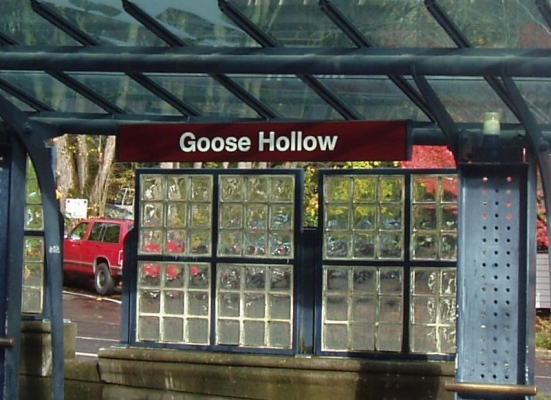Capstone students take on transportation challenges
Posted on June 18, 2014

The Goose Hollow MAX Station was the subject of one capstone groups redesign
Five teams of Portland State University seniors worked on projects in the transportation arena, as the final outcome of their Capstone course.
The transportation Capstone projects were completed under the advisement of Dr. Robert Bertini, a professor of Civil and Environmental Engineering at Portland State University and OTREC’s founding director.
Senior Capstone projects in engineering are about more than just technical aspects of design. They are an opportunity for students to meet with clients and consult with professionals, to develop the communication and collaboration skills which will be necessary in future careers.
John Edwards, a student team leader, described the project as a great opportunity. “We learned a great deal about project management and communication in working with professionals,” Edwards said.
In each project, students met with clients under the guidance of faculty to come up with solutions to problems that the clients were facing.
A group led by Krista Hager worked on a concept design for bicycle parking at the Goose Hollow eastbound MAX Station in southwest Portland, Ore.
The existing grade conditions and the fact that the site was in a confined area made the location challenging, but TriMet, the region’s transit provider, had identified a need for secure bike parking to accommodate 20?50 bicycles at the Goose Hollow Station.
The team worked closely with an active transportation planner at TriMet to gather rider data using CountCam hardware, to ensure that the design met the needs of the community.
Their final design layout featured cargo bike parking, a bicycle service station, secure parking for 45 bicycles, and 14 outdoor staple-style bike racks.
The proposed structure stands to promote commuting by bicycle, a goal of the active transport division of the Portland Bureau of Transportation (PBOT), as well as reduce stormwater runoff.
Jennifer Longmore’s group worked on Phase II of a project to redesign Montgomery Street, a heavily used thoroughfare on the PSU campus.
Students worked with City of Portland Environmental Services, the Portland Development Commission, and Portland State University.
Between southwest Broadway and 6th Avenue in downtown Portland, the street experiences high pedestrian traffic from the university, nearby businesses and public transportation stations. Concerns had been raised that the mixture of cars, bicycles, and pedestrians was creating unsafe conditions.
The project goal was to turn this segment of Montgomery into a pedestrian zone that meets “Green Street” design standards.
The team completed a traffic flow analysis, which showed no impact on the level of service of the alternative routes of motor vehicles.
Students designed a bioswale, in two sections less than 50 feet long with a check dam in the middle. They also submitted plans for regrading the pavement to cause water to run toward the middle of the street for bioswale treatment.
The end design stands to improve the safety of the street for non-motorized travelers and enhance the pedestrian environment through vibrant landscaping.
John Edwards’ group redesigned the first floor of a parking garage at the Sunset Transit Center in southwest Portland, Ore.
The primary concern for the parking garage was vehicle congestion during peak drop-off and pick-up times, as a result of “kiss and ride” transit users on the first floor.
The goal was to reconfigure the first floor parking layout to mitigate congestion and safety risks.
Students visited the site to watch how vehicles interacted with pedestrians, then submitted their recommendations for improvements along with a construction cost estimate.
Their designs include a dedicated drop-off/pick-up lane, clear signage and pedestrian control devices to require less interaction between vehicles and pedestrians, and a redesigned drainage system to reduce stormwater runoff.
The students’ plan is designed to create a safer pedestrian environment, a decrease in driver impatience, and decreased idle times which would lead to less vehicle emissions.
Gregory Kirkland’s team took a look at unimproved roadways within the city of Portland, specifically in the Tenino Ct area of southeast Portland.
There are approximately 60 miles of unpaved roadways in Portland, most of which are located in residential areas. The unimproved streets lack stormwater facilities, durable road surfacing, and sidewalks. These conditions negatively impact local watershed health and limit safe access for pedestrians, bicyclists and vehicles.
The purpose of the project was to develop a low-cost, effective design for the roadway improvement and stormwater facilities of Southeast Tenino Ct.
The capstone students propose to implement a combination of pervious concrete (to collect water) and sloped subgrade (to divert it into existing stormwater systems).
The design is aimed at improving accessibility, livability, and watershed health.
A team led by Alexander Wesolovski worked on an improvement to Oregon’s Historic Columbia River Highway (HCRH).
Located off of Interstate 84, the Eagle Creek Trail is the most popular trail in the Columbia River Gorge. Currently, a staircase connects the old trail from the cliffs above the HCRH to a trail running eastward.
The Oregon Department of Transportation was looking for an economically feasible solution to replace the Eagle Creek staircase with a more accessible option for hikers and bicyclists, while also meeting the criteria of the Americans with Disabilities Act (ADA) guidelines.
Wesolovski’s team came up with a plan which meets the ADA grade requirements, and includes and water runoff catchment and drainage system.
Their design features a limited number of switchbacks to preserve the natural aesthetics of the location, new railings that conform to HCRH’s design criteria, and retaining walls for slope stabilization and erosion control.
Capstone courses such as this one are designed by Portland State University to bring as much real-world experience into projects as possible, allowing seniors the chance to develop skills that will benefit them as they move into professional fields.
